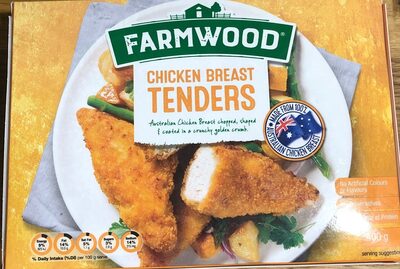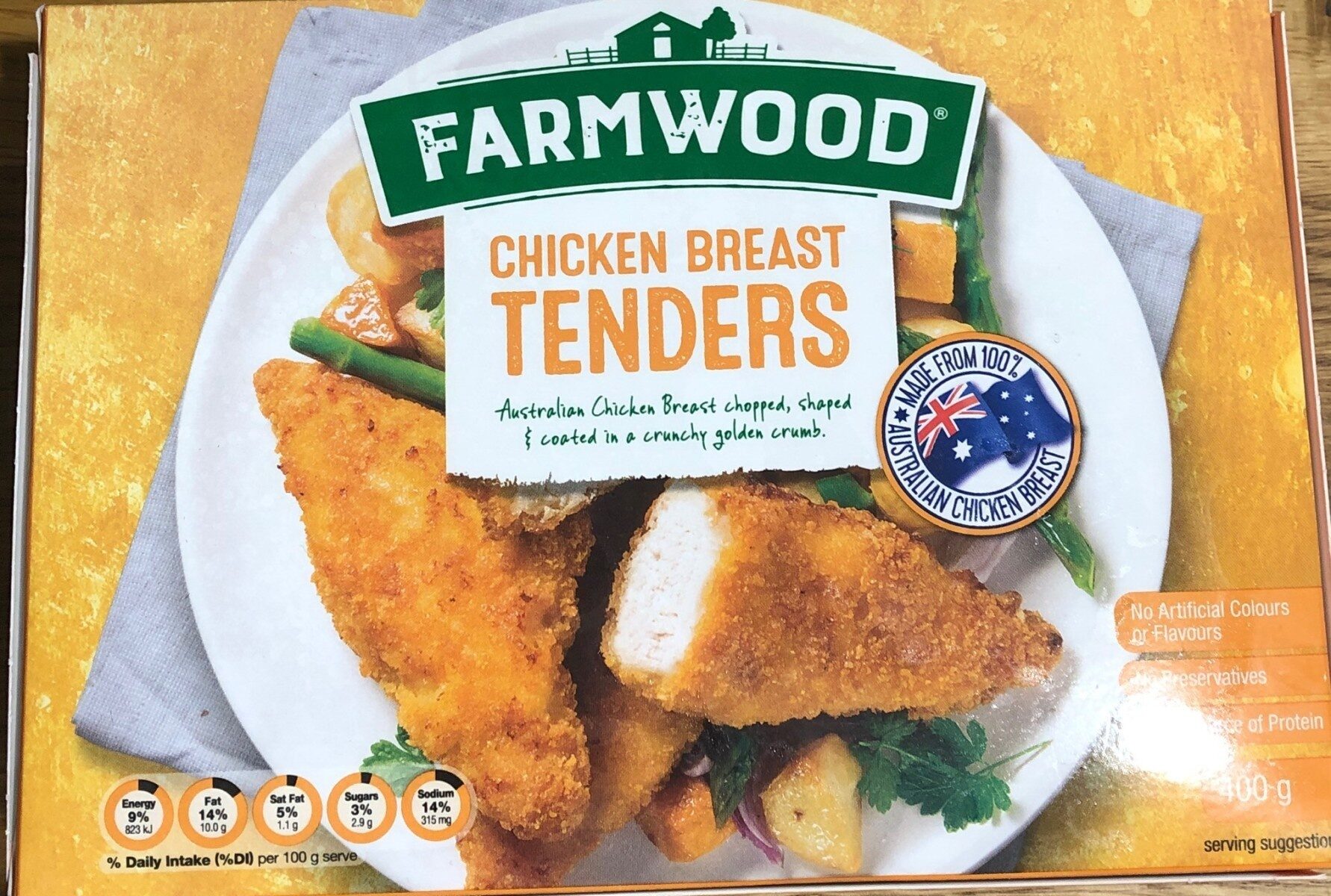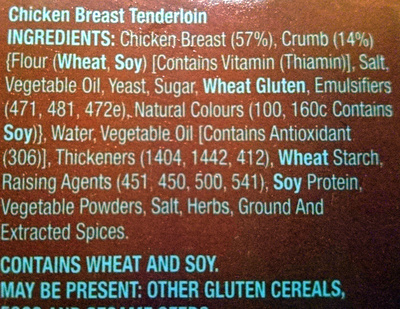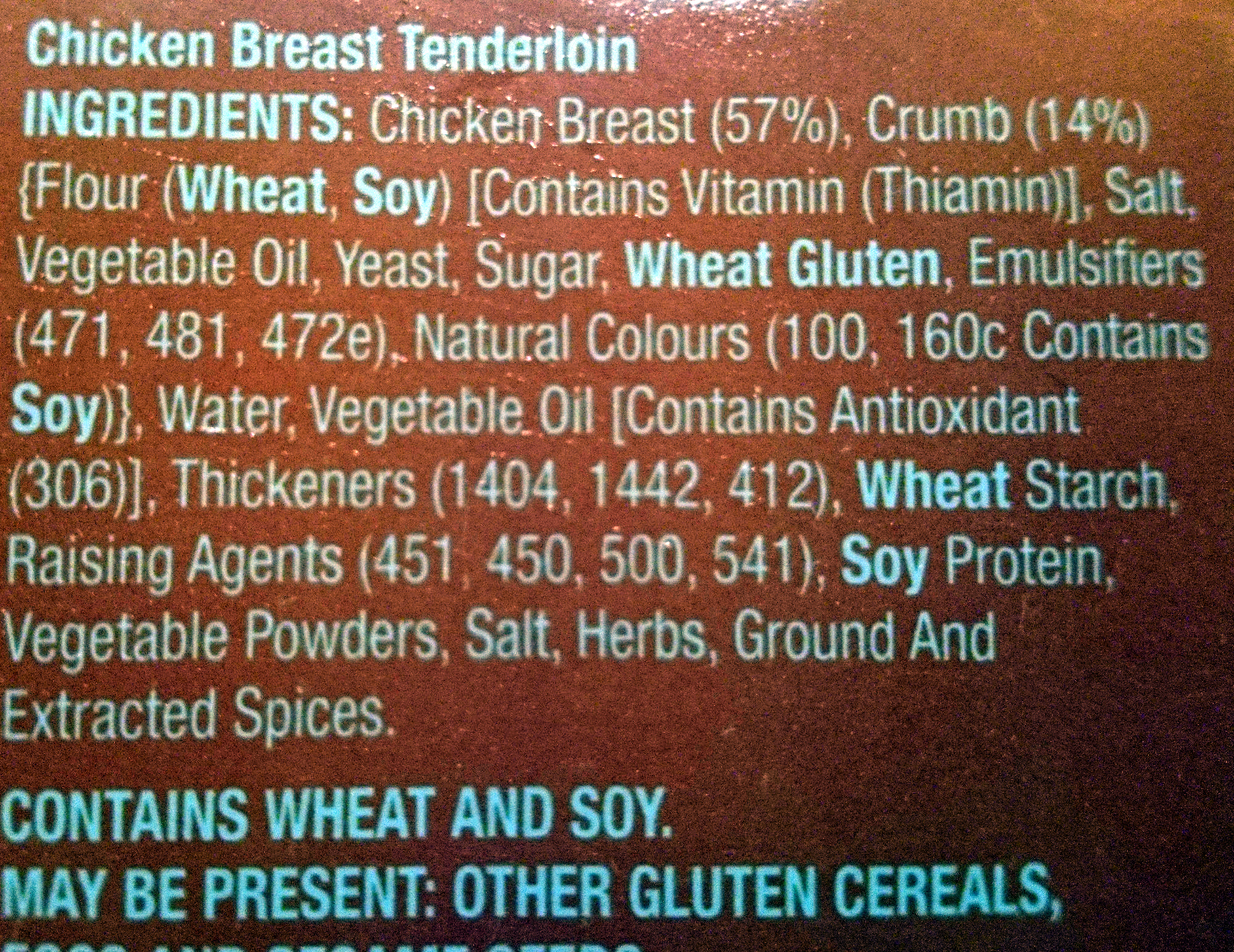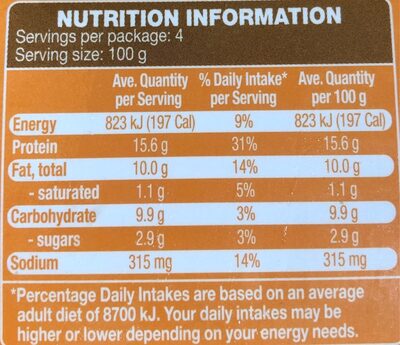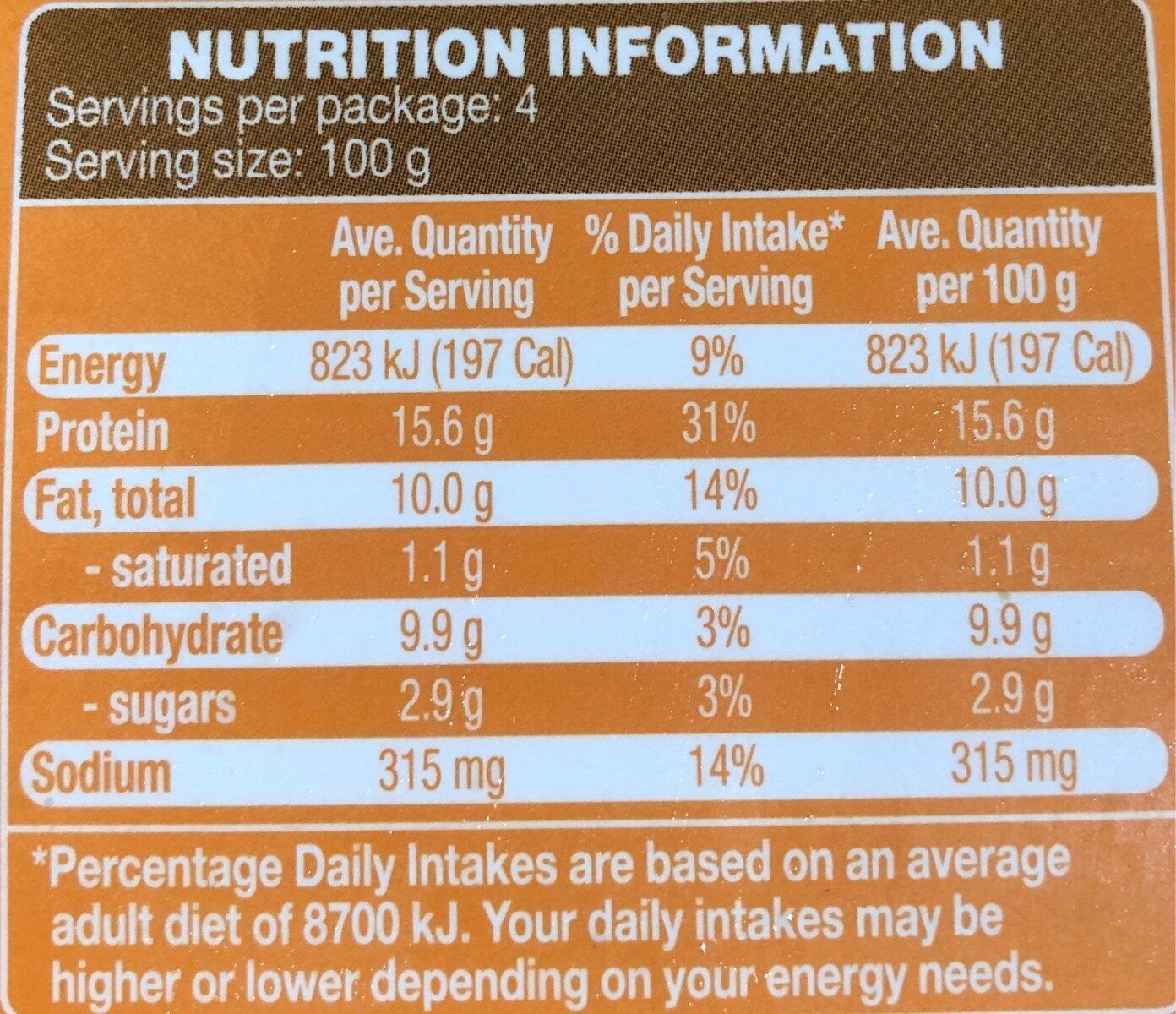Help us make food transparency the norm!
As a non-profit organization, we depend on your donations to continue informing consumers around the world about what they eat.
The food revolution starts with you!
Chicken breast tenders - Farmwood - 400g Frozen
Chicken breast tenders - Farmwood - 400g Frozen
Ambiguous barcode: This product has a Restricted Circulation Number barcode for products within a company. This means that different producers and stores can use the same barcode for different products.
×
This product page is not complete. You can help to complete it by editing it and adding more data from the photos we have, or by taking more photos using the app for Android or iPhone/iPad. Thank you!
×
Barcode: 26117430
Quantity: 400g Frozen
Categories: Meats and their products, Frozen foods, Meats, Chicken and its products, Poultries, Frozen meats, Chickens, Frozen Chicken
Labels, certifications, awards: Australian made
Origin of ingredients: Australia
Manufacturing or processing places: Australia
Stores: Aldi
Countries where sold: Australia
Matching with your preferences
Health
Ingredients
-
38 ingredients
Chicken-Breast (57%), Crumb (14%) Flour (Wheat, Soy) [Contains Vitamin (Thiamin)], Salt, Vegetable Oil, Yeast, Sugar, Wheat Gluten, Emulsifiers (471, 481, 472e) Natural Colours (100, 160c Contains Soy), Water, Vegetable. Oil (Contains Antioxidant (306)], Thickeners (1404, 1442, 412), Wheat Starch, Raising Agents (451, 450, 500,541), Soy Protein, Vegetable Powders, Salt, Herbs, Ground And Extracted Spices.Allergens: Gluten, SoybeansTraces: Gluten, Cereals
Food processing
-
Ultra processed foods
Elements that indicate the product is in the 4 - Ultra processed food and drink products group:
- Additive: E100 - Curcumin
- Additive: E1404 - Oxidised starch
- Additive: E1442 - Hydroxypropyl distarch phosphate
- Additive: E160c - Paprika extract
- Additive: E412 - Guar gum
- Additive: E450 - Diphosphates
- Additive: E451 - Triphosphates
- Additive: E471 - Mono- and diglycerides of fatty acids
- Additive: E481 - Sodium stearoyl-2-lactylate
- Ingredient: Colour
- Ingredient: Emulsifier
- Ingredient: Gluten
- Ingredient: Thickener
Food products are classified into 4 groups according to their degree of processing:
- Unprocessed or minimally processed foods
- Processed culinary ingredients
- Processed foods
- Ultra processed foods
The determination of the group is based on the category of the product and on the ingredients it contains.
Additives
-
E1442 - Hydroxypropyl distarch phosphate
Hydroxypropyl distarch phosphate: Hydroxypropyl distarch phosphate -HDP- is a modified resistant starch. It is currently used as a food additive -INS number 1442-. It is approved for use in the European Union -listed as E1442-, the United States, Australia, Taiwan, and New Zealand.Source: Wikipedia
-
E412 - Guar gum
Guar gum (E412) is a natural food additive derived from guar beans.
This white, odorless powder is valued for its remarkable thickening and stabilizing properties, making it a common ingredient in various food products, including sauces, dressings, and ice creams.
When used in moderation, guar gum is considered safe for consumption, with no known adverse health effects.
-
E450 - Diphosphates
Diphosphates (E450) are food additives often utilized to modify the texture of products, acting as leavening agents in baking and preventing the coagulation of canned food.
These salts can stabilize whipped cream and are also found in powdered products to maintain their flow properties. They are commonly present in baked goods, processed meats, and soft drinks.
Derived from phosphoric acid, they're part of our daily phosphate intake, which often surpasses recommended levels due to the prevalence of phosphates in processed foods and drinks.
Excessive phosphate consumption is linked to health issues, such as impaired kidney function and weakened bone health. Though diphosphates are generally regarded as safe when consumed within established acceptable daily intakes, it's imperative to monitor overall phosphate consumption to maintain optimal health.
-
E451 - Triphosphates
Sodium triphosphate: Sodium triphosphate -STP-, also sodium tripolyphosphate -STPP-, or tripolyphosphate -TPP-,- is an inorganic compound with formula Na5P3O10. It is the sodium salt of the polyphosphate penta-anion, which is the conjugate base of triphosphoric acid. It is produced on a large scale as a component of many domestic and industrial products, especially detergents. Environmental problems associated with eutrophication are attributed to its widespread use.Source: Wikipedia
-
E471 - Mono- and diglycerides of fatty acids
Mono- and diglycerides of fatty acids (E471), are food additives commonly used as emulsifiers in various processed foods.
These compounds consist of glycerol molecules linked to one or two fatty acid chains, which help stabilize and blend water and oil-based ingredients. E471 enhances the texture and shelf life of products like margarine, baked goods, and ice cream, ensuring a smooth and consistent texture.
It is generally considered safe for consumption within established regulatory limits.
-
E481 - Sodium stearoyl-2-lactylate
Sodium stearoyl lactylate: Sodium stearoyl-2-lactylate -sodium stearoyl lactylate or SSL- is a versatile, FDA approved food additive used to improve the mix tolerance and volume of processed foods. It is one type of a commercially available lactylate. SSL is non-toxic, biodegradable, and typically manufactured using biorenewable feedstocks. Because SSL is a safe and highly effective food additive, it is used in a wide variety of products ranging from baked goods and desserts to pet foods.As described by the Food Chemicals Codex 7th edition, SSL is a cream-colored powder or brittle solid. SSL is currently manufactured by the esterification of stearic acid with lactic acid and partially neutralized with either food-grade soda ash -sodium carbonate- or caustic soda -concentrated sodium hydroxide-. Commercial grade SSL is a mixture of sodium salts of stearoyl lactylic acids and minor proportions of other sodium salts of related acids. The HLB for SSL is 10-12. SSL is slightly hygroscopic, soluble in ethanol and in hot oil or fat, and dispersible in warm water. These properties are the reason that SSL is an excellent emulsifier for fat-in-water emulsions and can also function as a humectant.Source: Wikipedia
-
E500 - Sodium carbonates
Sodium carbonates (E500) are compounds commonly used in food preparation as leavening agents, helping baked goods rise by releasing carbon dioxide when they interact with acids.
Often found in baking soda, they regulate the pH of food, preventing it from becoming too acidic or too alkaline. In the culinary world, sodium carbonates can also enhance the texture and structure of foods, such as noodles, by modifying the gluten network.
Generally recognized as safe, sodium carbonates are non-toxic when consumed in typical amounts found in food.
-
E541 - Sodium aluminium phosphate
Sodium aluminium phosphate: Sodium aluminium phosphate -SAlP- describes the inorganic compounds consisting of sodium salts of aluminium phosphates. The most common SAlP has the formulas NaH14Al3-PO4-8·4H2O and Na3H15Al2-PO4-8. These materials are prepared by combining alumina, phosphoric acid, and sodium hydroxide.In addition to the usual hydrate, an anhydrous SAlP is also known, Na3H15Al2-PO4-8 -CAS#10279-59-1-, referred to as 8:2:3, reflecting the ratio of phosphate to aluminium to sodium. Additionally an SAlP of ill-defined stoichiometry is used -NaxAly-PO4-z -CAS# 7785-88-8-.The acidic sodium aluminium phosphates are used as acids for baking powders for the chemical leavening of baked goods. Upon heating, SAlP combines with the baking soda to give carbon dioxide. Most of its action occurs at baking temperatures, rather than when the dough or batter is mixed at room temperature. SAlPs are advantageous because they impart a neutral flavor. As a food additive, it has the E number E541. Basic sodium aluminium phosphates are also known, e.g., Na15Al3-PO4-8. These species are useful in cheese making.Source: Wikipedia
Ingredients analysis
-
May contain palm oil
Ingredients that may contain palm oil: Vegetable oil, Oil
-
Non-vegan
Non-vegan ingredients: Chicken breastSome ingredients could not be recognized.
We need your help!
You can help us recognize more ingredients and better analyze the list of ingredients for this product and others:
- Edit this product page to correct spelling mistakes in the ingredients list, and/or to remove ingredients in other languages and sentences that are not related to the ingredients.
- Add new entries, synonyms or translations to our multilingual lists of ingredients, ingredient processing methods, and labels.
If you would like to help, join the #ingredients channel on our Slack discussion space and/or learn about ingredients analysis on our wiki. Thank you!
-
Non-vegetarian
Non-vegetarian ingredients: Chicken breastSome ingredients could not be recognized.
We need your help!
You can help us recognize more ingredients and better analyze the list of ingredients for this product and others:
- Edit this product page to correct spelling mistakes in the ingredients list, and/or to remove ingredients in other languages and sentences that are not related to the ingredients.
- Add new entries, synonyms or translations to our multilingual lists of ingredients, ingredient processing methods, and labels.
If you would like to help, join the #ingredients channel on our Slack discussion space and/or learn about ingredients analysis on our wiki. Thank you!
-
Details of the analysis of the ingredients
We need your help!
Some ingredients could not be recognized.
We need your help!
You can help us recognize more ingredients and better analyze the list of ingredients for this product and others:
- Edit this product page to correct spelling mistakes in the ingredients list, and/or to remove ingredients in other languages and sentences that are not related to the ingredients.
- Add new entries, synonyms or translations to our multilingual lists of ingredients, ingredient processing methods, and labels.
If you would like to help, join the #ingredients channel on our Slack discussion space and/or learn about ingredients analysis on our wiki. Thank you!
: Chicken-Breast 57%, Crumb 14%, Flour (_Wheat_, _Soy_, Contains Vitamin (Thiamin)), Salt, Vegetable Oil, Yeast, Sugar, Wheat Gluten, Emulsifiers (471, 481, 472e), Natural Colours (100, 160c), Water, Vegetable, Oil, Contains Antioxidant (306), Thickeners (1404, 1442, 412), _Wheat_ Starch, Raising Agents (451, 450, 500‚541), Soy Protein, Vegetable Powders, Salt, Herbs, Spices- Chicken-Breast -> en:chicken-breast - vegan: no - vegetarian: no - ciqual_food_code: 36018 - percent: 57
- Crumb -> en:crumb - percent: 14
- Flour -> en:flour - vegan: yes - vegetarian: yes - ciqual_proxy_food_code: 9410
- _Wheat_ -> en:wheat - vegan: yes - vegetarian: yes - ciqual_proxy_food_code: 9410
- _Soy_ -> en:soya - vegan: yes - vegetarian: yes
- Contains Vitamin -> en:vitamins - vegan: yes - vegetarian: yes
- Thiamin -> en:thiamin
- Salt -> en:salt - vegan: yes - vegetarian: yes - ciqual_food_code: 11058
- Vegetable Oil -> en:vegetable-oil - vegan: yes - vegetarian: yes - from_palm_oil: maybe
- Yeast -> en:yeast - vegan: yes - vegetarian: yes
- Sugar -> en:sugar - vegan: yes - vegetarian: yes - ciqual_proxy_food_code: 31016
- Wheat Gluten -> en:wheat-gluten - vegan: yes - vegetarian: yes
- Emulsifiers -> en:emulsifier
- 471 -> en:471
- 481 -> en:481
- 472e -> en:472e
- Natural Colours -> en:natural-colours
- 100 -> en:100
- 160c -> en:160c
- Water -> en:water - vegan: yes - vegetarian: yes - ciqual_food_code: 18066
- Vegetable -> en:vegetable - vegan: yes - vegetarian: yes
- Oil -> en:oil - vegan: maybe - vegetarian: maybe - from_palm_oil: maybe
- Contains Antioxidant -> en:antioxidant
- 306 -> en:306
- Thickeners -> en:thickener
- 1404 -> en:1404
- 1442 -> en:1442
- 412 -> en:412
- _Wheat_ Starch -> en:wheat-starch - vegan: yes - vegetarian: yes - ciqual_proxy_food_code: 9510
- Raising Agents -> en:raising-agent
- 451 -> en:451
- 450 -> en:450
- 500‚541 -> en:500-541
- Soy Protein -> en:soy-protein - vegan: yes - vegetarian: yes - ciqual_food_code: 20591
- Vegetable Powders -> en:vegetable-powders
- Salt -> en:salt - vegan: yes - vegetarian: yes - ciqual_food_code: 11058
- Herbs -> en:herb - vegan: yes - vegetarian: yes
- Spices -> en:spice - vegan: yes - vegetarian: yes
Nutrition
-
Very good nutritional quality
⚠ ️Warning: the amount of fiber is not specified, their possible positive contribution to the grade could not be taken into account.⚠ ️Warning: the amount of fruits, vegetables and nuts is not specified on the label, it was estimated from the list of ingredients: 0This product is not considered a beverage for the calculation of the Nutri-Score.
Positive points: 5
- Proteins: 5 / 5 (value: 15.60000038147, rounded value: 15.6)
- Fiber: 0 / 5 (value: 0, rounded value: 0)
- Fruits, vegetables, nuts, and colza/walnut/olive oils: 0 / 5 (value: 0.0283203125, rounded value: 0)
Negative points: 4
- Energy: 2 / 10 (value: 824, rounded value: 824)
- Sugars: 0 / 10 (value: 2.9000000953674, rounded value: 2.9)
- Saturated fat: 1 / 10 (value: 1.1000000238419, rounded value: 1.1)
- Sodium: 1 / 10 (value: 125.999999046324, rounded value: 126)
The points for proteins are counted because the negative points are less than 11.
Nutritional score: (4 - 5)
Nutri-Score:
-
Nutrient levels
-
Fat in moderate quantity (10%)
What you need to know- A high consumption of fat, especially saturated fats, can raise cholesterol, which increases the risk of heart diseases.
Recommendation: Limit the consumption of fat and saturated fat- Choose products with lower fat and saturated fat content.
-
Saturated fat in low quantity (1.1%)
What you need to know- A high consumption of fat, especially saturated fats, can raise cholesterol, which increases the risk of heart diseases.
Recommendation: Limit the consumption of fat and saturated fat- Choose products with lower fat and saturated fat content.
-
Sugars in low quantity (2.9%)
What you need to know- A high consumption of sugar can cause weight gain and tooth decay. It also augments the risk of type 2 diabetes and cardio-vascular diseases.
Recommendation: Limit the consumption of sugar and sugary drinks- Sugary drinks (such as sodas, fruit beverages, and fruit juices and nectars) should be limited as much as possible (no more than 1 glass a day).
- Choose products with lower sugar content and reduce the consumption of products with added sugars.
-
Salt in moderate quantity (0.315%)
What you need to know- A high consumption of salt (or sodium) can cause raised blood pressure, which can increase the risk of heart disease and stroke.
- Many people who have high blood pressure do not know it, as there are often no symptoms.
- Most people consume too much salt (on average 9 to 12 grams per day), around twice the recommended maximum level of intake.
Recommendation: Limit the consumption of salt and salted food- Reduce the quantity of salt used when cooking, and don't salt again at the table.
- Limit the consumption of salty snacks and choose products with lower salt content.
-
-
Nutrition facts
Nutrition facts As sold
for 100 g / 100 mlCompared to: Frozen meats Energy 824 kj
(197 kcal)-4% Fat 10 g -9% Saturated fat 1.1 g -36% Carbohydrates 9.9 g -27% Sugars 2.9 g +40% Fiber ? Proteins 15.6 g +19% Salt 0.315 g -70% Fruits‚ vegetables‚ nuts and rapeseed‚ walnut and olive oils (estimate from ingredients list analysis) 0.028 %
Environment
-
Eco-Score D - High environmental impact
⚠ ️The full impact of transportation to your country is currently unknown.The Eco-Score is an experimental score that summarizes the environmental impacts of food products.→ The Eco-Score was initially developped for France and it is being extended to other European countries. The Eco-Score formula is subject to change as it is regularly improved to make it more precise and better suited to each country.Life cycle analysis
-
Average impact of products of the same category: C (Score: 41/100)
Category: Chicken, meat and skin, raw
Category: Chicken, meat and skin, raw
- PEF environmental score: 0.71 (the lower the score, the lower the impact)
- including impact on climate change: 5.52 kg CO2 eq/kg of product
Stage Impact Agriculture
82.8 %Processing
10.5 %Packaging
2.5 %Transportation
2.6 %Distribution
1.3 %Consumption
0.3 %
Bonuses and maluses
-
Origins of ingredients with a high impact
Malus:
Environmental policy: +3
Transportation: 0
Origin of the product and/or its ingredients % of ingredients Impact Australia 100 %Medium
-
Packaging with a medium impact
Malus: -10
Shape Material Recycling Impact Box Unknown High ⚠ ️ The information about the packaging of this product is not sufficiently precise (exact shapes and materials of all components of the packaging).⚠ ️ For a more precise calculation of the Eco-Score, you can modify the product page and add them.
If you are the manufacturer of this product, you can send us the information with our free platform for producers.
Eco-Score for this product
-
Impact for this product: D (Score: 34/100)
Product: Chicken breast tenders - Farmwood - 400g Frozen
Life cycle analysis score: 41
Sum of bonuses and maluses: -10
Final score: 34/100
-
Carbon footprint
-
Equal to driving 2.9 km in a petrol car
552 g CO² per 100g of product
The carbon emission figure comes from ADEME's Agribalyse database, for the category: Chicken, meat and skin, raw (Source: ADEME Agribalyse Database)
Stage Impact Agriculture
75.1 %Processing
14.9 %Packaging
5.0 %Transportation
4.2 %Distribution
0.7 %Consumption
0.1 %
Packaging
-
Packaging with a medium impact
-
Packaging parts
Box
-
Packaging materials
Material % Packaging weight Packaging weight per 100 g of product
-
Transportation
-
Origins of ingredients
Origins of ingredients with a high impact
Origin of the product and/or its ingredients % of ingredients Impact Australia 100 %Medium
Report a problem
-
Incomplete or incorrect information?
Category, labels, ingredients, allergens, nutritional information, photos etc.
If the information does not match the information on the packaging, please complete or correct it. Open Food Facts is a collaborative database, and every contribution is useful for all.
Data sources
Product added on by foodorigins
Last edit of product page on by packbot.
Product page also edited by clockwerx, kiliweb, yuka.ILxPLv-COu8KMsb8jIgvgASaDvqxDdACEiUsow.
